Ever hear a founder say, “We’re raising $1 million,” and wonder—why that number?
Founders often toss out round figures like they’re playing startup bingo: $500K, $1M, $2.5M. Ask where it came from, and you’ll get answers like “It felt right” or “That’s what others raise at our stage.”
Ouch.
That’s not a funding strategy. That’s financial improv.
Let’s fix that.
Founders Who Fund the Plan Win
Here’s the mindset shift: The amount you’re raising is not the starting point. It’s the outcome of a well-thought-through journey.
If I were coaching you right now, I’d say this:
Don’t ask how much you want to raise. Ask what you need to achieve.
Because investors don’t fund dreams. They fund credible plans.
They want to see:
- The milestones your raise will unlock.
- The key risks you’ve identified.
- The specific levers in your stack: CAC, AOV, LTV, COGS, and retention.
- The experiments you’ll run to turn vision into traction.
- The runway you’ve budgeted for, down to the last dollar.
A fuzzy ask kills faster than a fuzzy deck. It screams, “I haven’t done the math.”
Step 1: Reverse-Engineer the Raise
Start with your destination. What milestone gets you to the next round of funding; or better yet, to break-even?
This could be:
- $100K MRR with healthy retention
- CAC payback under 6 months
- 10K paying customers with product-led expansion
In ecommerce, that could be:
- $250K MRR with 35% gross margin
- CAC payback under 3 months from Meta or TikTok
- 20% of revenue from repeat customers
- Inventory turns every 45 days
Now map the route to get there.
What needs to be built, tested, hired, shipped?
Then ask:
- What’s the absolute minimum capital to prove real traction?
- What’s the ideal round size if oversubscribed?
- How long should the cash last? 12–18 months is standard.
This gives you a tight range, not a random guess. Now you’re planning like a founder who understands capital as a tool, not a trophy.
Step 2: Tie Every Dollar to an Outcome
Too many pitch decks include a slide that says, “We’re raising $2M to scale.”
Scale what?
Instead, break the raise into specific use cases.
For example:
- $600K for paid CAC testing and funnel optimization
- $500K for engineering two core features tied to retention
- $400K for hiring two AEs and building the GTM playbook
- $250K for burn buffer and contingency testing
- $250K for inventory purchases across three new SKUs with higher margins
- $150K to build retention campaigns and loyalty programs (email, SMS, post-purchase flows)
- $100K for upgrading the 3PL and warehouse systems to reduce fulfillment lag and returns
- $100K for hiring one key operator: Head of Supply Chain or Growth Marketing
Each line item should answer: What outcome will this unlock?
You’re not burning money. You’re buying learning curves and momentum.
Step 3: Model Like a Sci-Fi Engineer
Think of your financial model like the blueprint of a spaceship.
You haven’t launched yet, but everything better be thought through.
Every dollar allocated. Every contingency padded for. Every risk considered.
I tell founders to model like hard science fiction. Not fantasy. Not vibes. Science-based, but imaginative.
A great model does three things:
- Shows the minimum viable raise to hit meaningful traction.
- Outlines the stretch raise with added firepower if oversubscribed.
- Helps you decide when to stop fundraising and start executing.
You’re not asking for fuel to keep the engine on. You’re asking for enough to reach orbit.
Step 4: Kill the Vague Raise Slide
The Raise slide is where great pitches go to die.
It’s a shame. You’ve captured investor attention. You’ve built narrative tension. Then boom—“We’re raising $2M to build the team and see what happens.”
That’s not a raise. That’s a shrug.
The better version?
“We’re raising $1.75M to fund 14 months of runway across two experiments: testing influencer-driven CAC channels and improving post-purchase retention flows. That gets us to $300K MRR with profitable unit economics and sets us up for a growth equity round.”
Now you’re not just raising money. You’re inviting investors to co-pilot a specific mission.
Step 5: Get Outside Eyes on It
Before you pitch, pressure test your raise.
Not with your cofounder. Not with your dog. With someone who’s seen 100+ decks this year.
They’ll spot the fluff. They’ll push on your assumptions. They’ll help you sharpen the story and the ask.
You don’t want to sound like every other founder. You want your raise to sound inevitable because the logic is airtight.
Final Reflection: Raise With Purpose, Not Ego
The best raise isn’t the biggest. It’s the most believable.
It’s built with clarity, grounded in logic, and designed to fuel growth not just inventory or headcount.
So stop reaching for a round number. Start building a roadmap.
You don’t need a war chest.
You need a plan.
And a destination that tells investors, “Here’s exactly how we win.”


